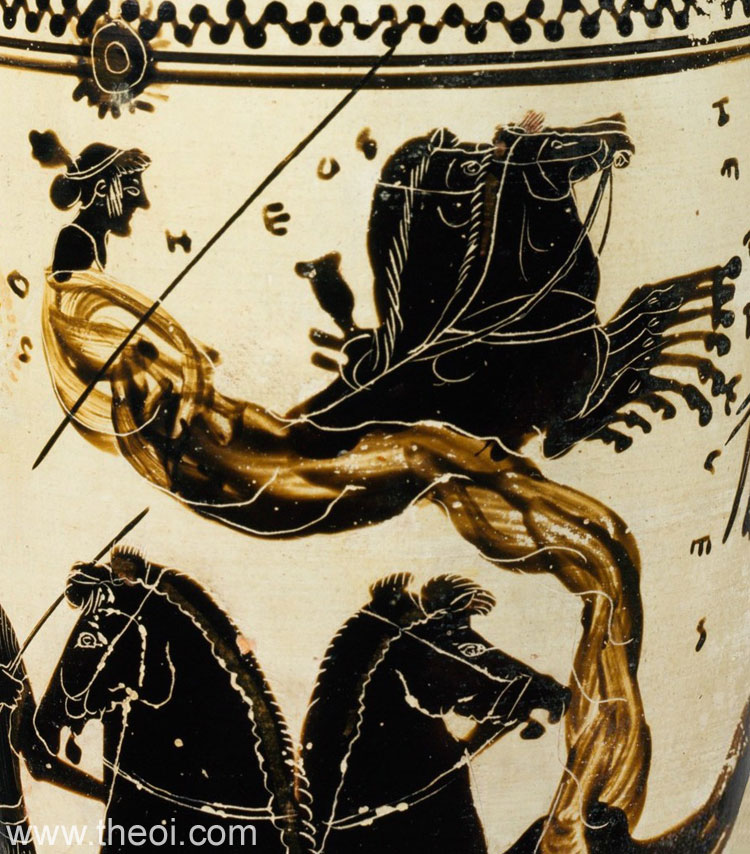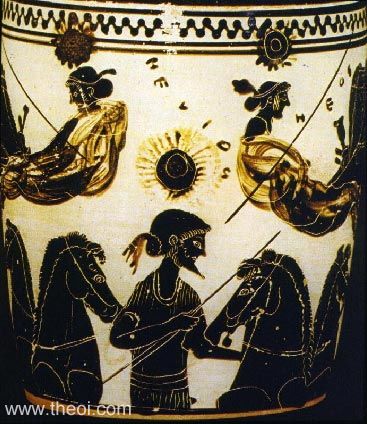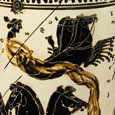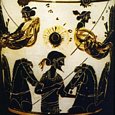Greek Primordial Goddess of the Day (Roman Dies) (original) (raw)
Greek Mythology >> Greek Gods >> Primordial Gods >> Sky Gods >> Hemera
HEMERA
Eos-Hemera goddess of day, Athenian black-figure lekythos C5th B.C., Metropolitan Museum of Art
HEMERA was the the primordial goddess (protogenos) of the day. She was a daughter of Erebos (Darkness) and Nyx (Night) and the sister and wife of Aither (Aether, Heavenly Light).
Every evening Hemera's mother Nyx drew her dark veil across the sky, obscuring the the shining blue of the heavenly ether (aither), and bringing night to earth. With each morn Hemera dispersed her mother's mists, bathing the earth again in the light of the ether. In the ancient cosmogonies night and day were actual substances distinct and independent of the sun. The sun ruled the day but was not its source.
Hemera was closely identified with Hera, the queen of heavens, and Eos, the goddess of the dawn. Hesiod seems to regard her as more of a divine substance rather than anthropomorphic goddess. She was largely irrelevant in mythology, with her role being entirely subsumed by the goddess Eos.
FAMILY OF HEMERA
PARENTS
[1.1] EREBOS & NYX (Hesiod Theogony 124, Cicero De Natura Deorum 3.17)
[1.2] EREBOS (Alcman Frag 5)
[2.1] KHRONOS & NYX (Bacchylides Frag 7)
[3.1] KHAOS (Hyginus Preface)
OFFSPRING
[1.1] GAIA, OURANOS, THALASSA (by Aither) (Hyginus Preface)
[1.2] OURANOS (by Aither) (Cicero De Natura Deorum 3.17)
ALTERNATE NAME SPELLINGS
Greek Name
Ἡμερη
Αμερα
Αμαρα
Transliteration
Hêmerê
Amera
Amara
Latin Spelling
Hemera
id.
id.
Translation
Day (Ionian spelling)
id. (Doric spelling)
id. (Locrian spelling)
CLASSICAL LITERATURE QUOTES
Nyx, Hemera-Heos and Helius, Athenian black-figure lekythos C5th B.C., Metropolitan Museum of Art
Hesiod, Theogony 115 ff (trans. Evelyn-White) (Greek epic C8th or C7th B.C.) :
"Verily at first Khaos (the Chasm) [Air] came to be, but next wide-bosomed Gaia (Gaea, Earth) . . . and dim Tartaros (Hell) in the depth of the wide-pathed Earth, and Eros (Love), fairest among the deathless gods, who unnerves the limbs and overcomes the mind and wise counsels of all gods and all men within them. From Khaos (Chaos, Air) came forth Erebos (Erebus, Darkness) and black Nyx (Night); but of Nyx (Night) were born Aither (Aether, Light) and Hemera (Day), whom she conceived and bore from union in love with Erebos. And Gaia (Earth) first bore starry Ouranos (Uranus, Heaven), equal to herself, to cover her on every side."
Hesiod, Theogony 744 ff :
"[At the ends of the earth, where lie the roots of earth, sea, Tartaros (Tartarus) :] There stands the awful home of murky Nyx wrapped in dark clouds. In front of it [Atlas] the son of Iapetos stands immovably upholding the wide heaven upon his head and unwearying hands, where Nyx (Night) and Hemera (Day) draw near and greet one another as they pass the great threshold of bronze : and while the one is about to go down into the house, the other comes out at the door. And the house never holds them both within; but always one is without the house passing over the earth, while the other stays at home and waits until the time for her journeying come; and the one holds all-seeing light (phaos) for them on earth."
Alcman, Fragment 5 (from Scholia) (trans. Campbell, Vol. Greek Lyric II) (Greek lyric C7th B.C.) :
"So at the same moment there came into being Poros (Porus) [perhaps Khronos (Chronos)] and Tekmor (Tecmor) [perhaps Ananke] and Skotos (Scotus, Darkness) [Erebos]. ‘Amar (Day) [Hemera] and Melana (Moon) [Selene] and third, Skotos (Scotus, Darkness) [Erebus] as far as Marmarugas (Flashings) [perhaps Aither]’ : days does not mean simply day, but contains the idea of the sun. Previously there was only darkness, and afterwards, when it had been differentiated, light came into being."
Bacchylides, Fragment 7 (trans. Campbell, Vol. Greek Lyric IV) (Greek lyric C5th B.C.) :
"Radiant daughter [Hemera (Day)] of Khronos (Chronos, Time) and Nyx (Night), you the sixteenth day of the fiftieth month."
Greek Lyric V Anonymous, Fragment 1010 (from Plutarch, Epicurus) (trans. Campbell) (Greek lyric B.C.) :
"The far-shining ambrosial face of horse-driving Hamera (Hemera)."
Philostratus the Elder, Imagines 1. 11 (trans. Fairbanks) (Greek rhetorician C3rd A.D.) :
"[From a description of an ancient Greek painting depicting the fall of Phaethon :] In his passion for driving this son of Helios (the Sun) [Phaethon] ventured to mount his father's chariot, but because he did not keep a firm rein he came to grief and fell into the Eridanos . . . Look! Nyx (Night) is driving Hemera (Day) from the noonday sky, and the sun's orb as it plunges toward the earth draws in its train the Astera (Stars). The Horai (Horae, Hours) abandon their posts at the gates and flee toward the gloom that rises to meet them."
Pseudo-Hyginus, Preface (trans. Grant) (Roman mythographer C2nd A.D.) :
"From Caligine (Mist) [was born] : Chaos.
From Chaos [was born] : Nox (Night) [Nyx], Dies (Day) [Hemera], Erebus (Darkness), Aether (Light). . .
From Aether [Aither] and Dies [Hemera] [were born] : Terra (Earth) [Gaia (Gaea)], Caelum (Sky) [Ouranos (Uranus)], Mare (Sea) [Thalassa]."
Cicero, De Natura Deorum 3. 17 (trans. Rackham) (Roman rhetorician C1st B.C.) :
"[If Caelum-Ouranos is a god then] the parents of Caelus [Ouranos (Uranus)], Aether (Upper Air) and Dies (Day) [Hemera], must be held to be gods . . . these are fabled to be the children of Erebus (Darkness) and Nox (Night) [Nyx]."
HEMERA IDENTIFIED WITH EOS
In the following versions of these myths, Hemera is synonymous with the goddess Eos.
Pausanias, Description of Greece 1. 3. 1 (trans. Jones) (Greek travelogue C2nd A.D.) :
"On the tiling of this portico [the Royal Portico at Athens] are images of . . . Hemera carrying away Kephalos (Cephalus), who was in love with him. His son was Phaethon."
Pausanias, Description of Greece 3. 18. 10 - 16 :
"[Depicted amongst the reliefs on the throne of Apollon at Amyklai (Amyclae) in Lakonia :] There is Kephalos (Cephalus), too, carried of by Hemera because of his beauty."
Pausanias, Description of Greece 5. 22. 2 :
"[At Olympia there] is a semicircular stone pedestal, an on it are Zeus, Thetis and Hemera entreating Zeus on behalf of their children. These are on the middle of the pedestal. There are Akhilleus (Achilles) and Memnon, one at either edge of the pedestal, representing a pair of combatants in position."
Philostratus the Elder, Imagines 1. 7 (trans. Fairbanks) (Greek rhetorician C3rd A.D.) :
"[From a description of an ancient Greek painting depicting the funeral of Memnon :] Eos (the Dawn) mourning over her son [Memnon] causes Helios (the Sun) to be downcast . . . Helios (the Sun) . . . consoles Hemera (the Day) [i.e. Eos]." [N.B. Here the names Eos and Hemera are used interchangeably.]
Callistratus, Descriptions 1 (trans. Fairbanks) (Greek rhetorician C4th A.D.) :
"The Aithiopan (Ethiopian) stone statue of Memnon also became vocal, the Memnon, who when Hemera (Day) came was filled with joy by her presence, and overcome by distress when she departed, groaned with grief."
Callistratus, Descriptions 9 :
"There was in Aithiopia (Ethiopia) an image of Memnon, the son of Tithonos (Tithonus) . . . it saluted rising Hemera (Day) [i.e. Eos], by its voice giving token of its joy and expressing delight at the arrival of its mother; and again, as day declined to night, it uttered piteous and mournful groans in grief at her departure. . . . The statue in question both lulled to rest the sorrows of Hemera (Day) and caused her to abandon her search for her son."
ANCIENT GREEK ART
N3.1 Chariot of Eos-Hemera
Athenian Black Figure Vase Painting C5th B.C.
T17.3 Nyx, Eos-Hemera, Helius
Athenian Black Figure Vase Painting C5th B.C.
SOURCES
GREEK
- Hesiod, Theogony - Greek Epic C8th - 7th B.C.
- Greek Lyric I Alcman, Fragments - Greek Lyric C7th B.C.
- Greek Lyric IV Bacchylides, Fragments - Greek Lyric C5th B.C.
- Greek Lyric V Anonymous, Fragments - Greek Lyric B.C.
- Pausanias, Description of Greece - Greek Travelogue C2nd A.D.
- Philostratus the Elder, Imagines - Greek Rhetoric C3rd A.D.
- Callistratus, Descriptions - Greek Rhetoric C4th A.D.
ROMAN
- Hyginus, Fabulae - Latin Mythography C2nd A.D.
- Cicero, De Natura Deorum - Latin Rhetoric C1st B.C.
OTHER SOURCES
Other references not currently quoted here: Lucian Dialogue of Sailors 11.
BIBLIOGRAPHY
A complete bibliography of the translations quoted on this page.



